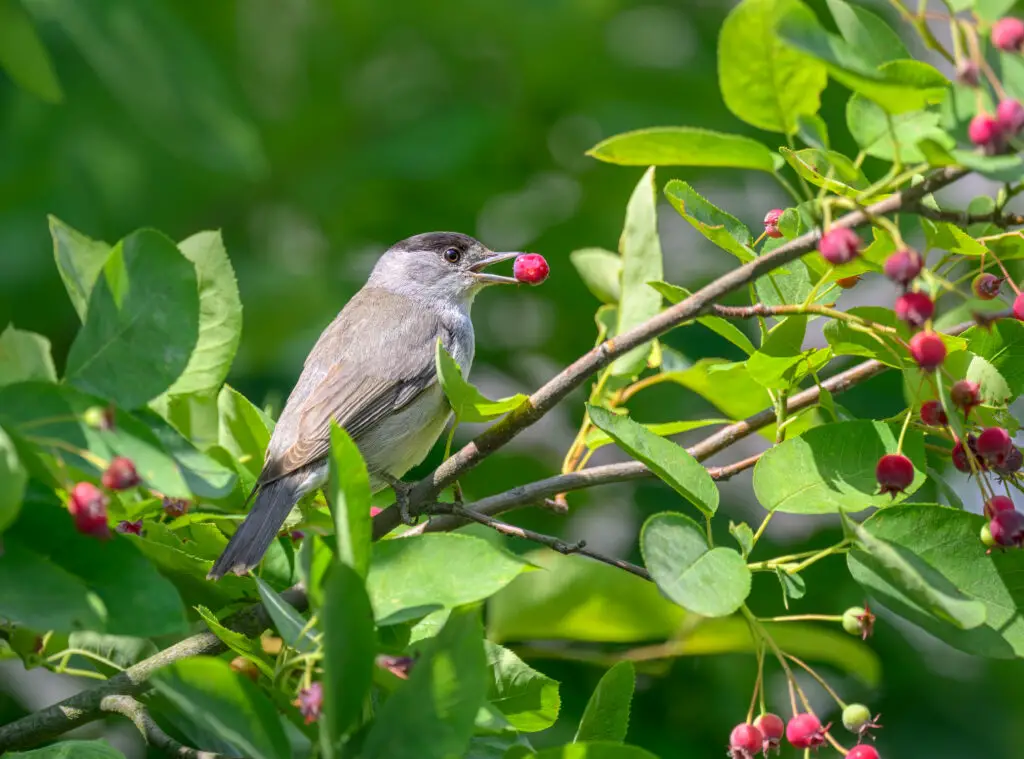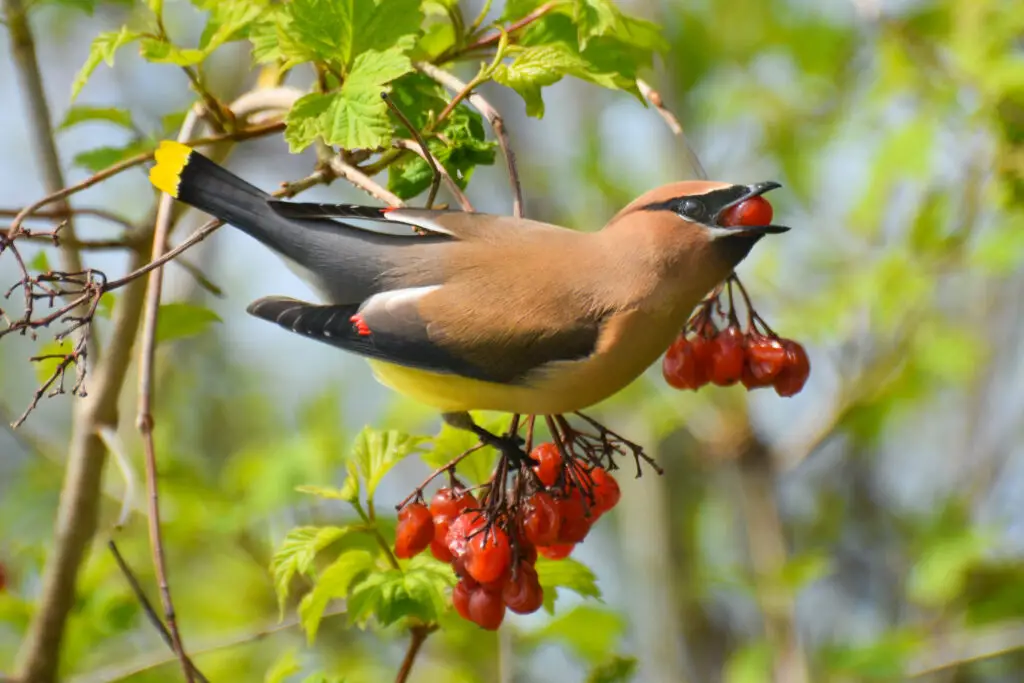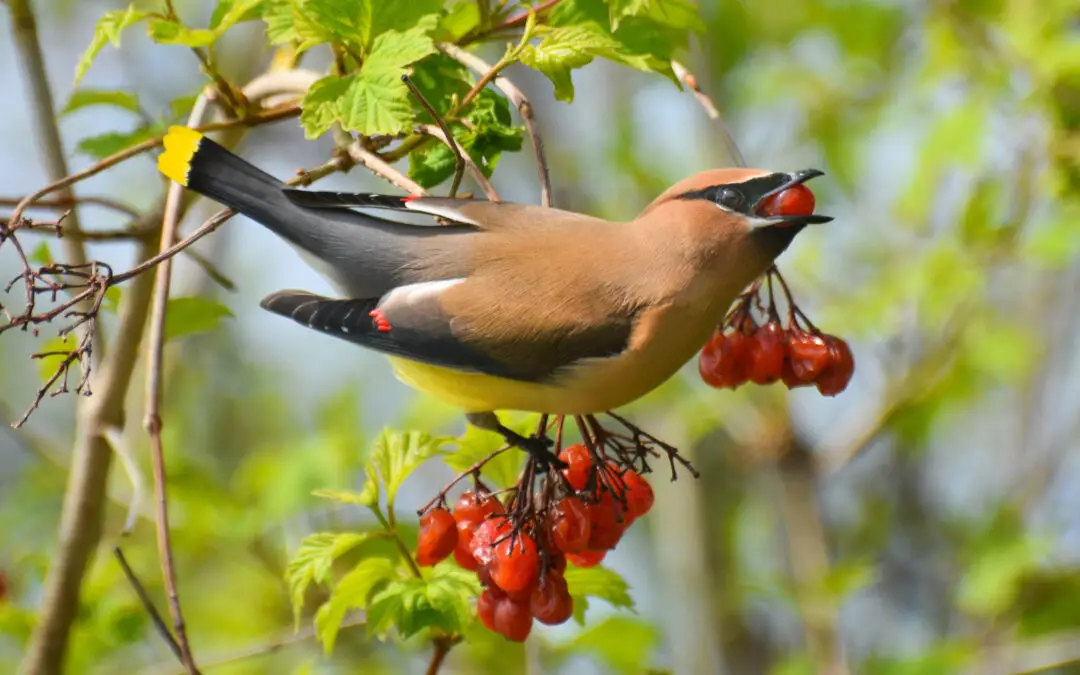Birds have been observed consuming a variety of berries, including those that contain toxic compounds. The ability of birds to ingest and process poisonous berries without apparent harm raises questions about the mechanisms that allow them to do so.
This article aims to explore the phenomenon of how birds are able to eat poisonous berries. It will investigate the specialized digestive system of birds, as well as their detoxification mechanisms, selective feeding behavior, and adaptation to poisonous plants.
Additionally, this article will examine the relationship between birds and poisonous berries from an evolutionary perspective and discuss the implications for conservation and ecological balance.
By adopting an academic style of writing that is objective and impersonal, this exploration seeks to provide a comprehensive understanding of how birds are able to consume these potentially harmful fruits in their natural habitats.

Specialized Digestive System of Birds
The specialized digestive system in birds allows for the consumption of poisonous berries without adverse effects. This unique adaptation provides evolutionary advantages to birds by expanding their food source options.
Birds have coevolved with many plants that produce toxic compounds as a defense mechanism against herbivory. To counteract these toxins, birds possess a highly efficient digestive system that enables them to safely process and eliminate harmful substances.
The secretion of certain enzymes, such as glycosidases, helps break down toxic compounds into non-toxic forms during digestion. Additionally, bird intestines are equipped with a region called the ceca where fermentation takes place, further aiding in detoxification processes.
These evolutionary adaptations demonstrate the intricate coevolutionary interactions between birds and plants, allowing birds to exploit resources that would otherwise be inaccessible due to toxicity.
Detoxification Mechanisms
Detoxification mechanisms in avian species enable the consumption of toxic berries. Birds have evolved these mechanisms due to the evolutionary pressures they face, such as competition for food resources and the need to consume a diverse diet.
One key mechanism is the presence of detoxification enzymes in their digestive system. These enzymes are capable of breaking down harmful substances found in poisonous berries, rendering them less toxic or even non-toxic. For example, certain birds possess high levels of cytochrome P450 enzymes, which play a crucial role in metabolizing toxins.
Additionally, some bird species have specialized gut bacteria that aid in detoxification processes. These bacteria help break down toxic compounds, allowing birds to safely consume berries that would otherwise be harmful.
These detoxification mechanisms allow birds to exploit food sources that might otherwise be inaccessible or dangerous, highlighting their remarkable adaptability and survival strategies in challenging environments.
Selective Feeding Behavior
Selective feeding behavior in avian species is a strategic adaptation that enables them to maximize their nutritional intake while minimizing the potential risks associated with consuming certain food sources. Birds have evolved mechanisms that allow them to identify and avoid toxic berries, ensuring their survival in environments where such fruits are abundant.
This selective behavior can be attributed to an array of evolutionary advantages. Firstly, birds’ ability to discern between edible and poisonous berries allows them to obtain essential nutrients without compromising their health. Secondly, avoiding toxic berries reduces the likelihood of illness or death caused by ingestion of harmful substances. Finally, this behavior has ecological impacts as well, as it helps maintain the balance of plant populations by preventing excessive consumption of poisonous fruits.
Overall, selective feeding behavior in birds plays a crucial role in their survival and has significant ecological implications.
- Enables birds to obtain necessary nutrients
- Reduces the risk of illness or death
- Maintains the balance of plant populations
Adaptation to Poisonous Plants
Adaptation to toxic plants is a critical survival mechanism in avian species, enabling them to navigate the potential dangers of certain flora and ensure their long-term existence. Birds have evolved various strategies to cope with poisonous berries and other toxic plant materials. These adaptation strategies can be categorized into physiological and behavioral mechanisms.
Physiological adaptations involve changes at the cellular or biochemical level that allow birds to tolerate or detoxify harmful substances. For example, some bird species possess specialized enzymes that break down toxins present in poisonous berries. Behavioral adaptations, on the other hand, include selective feeding behavior and avoidance tactics. Birds may selectively consume only non-toxic parts of a plant or learn through trial and error which plants are safe to eat.
The co-evolutionary dynamics between birds and plants also play a crucial role in shaping these adaptation strategies. As plants develop more potent toxins as a defense mechanism against herbivores, birds evolve countermeasures to overcome these defenses. This ongoing arms race between plants and birds has led to the remarkable ability of some avian species to consume poisonous berries without suffering ill effects.
| Adaptation Strategies | Co-evolutionary Dynamics |
|---|---|
| Physiological Mechanisms | Plants develop potent toxins as defense mechanisms |
| Behavioral Mechanisms | Birds evolve countermeasures |
In conclusion, adaptation to toxic plants is essential for bird survival. Through physiological and behavioral mechanisms, birds have developed ways to cope with the challenges posed by poisonous berries and other toxic plant materials. The co-evolutionary dynamics between birds and plants have further influenced these adaptation strategies, highlighting the complex relationship between avian species and their dietary choices in the face of potentially harmful flora.
Relationship Between Birds and Poisonous Berries
Birds and poisonous berries engage in a complex ecological dance, where avian species interact with these vibrant fruits in a delicate balance of survival and coexistence. The relationship between birds and poisonous berries is multifaceted, with both parties benefiting from their interaction.
- Birds play a vital role in seed dispersal, as they consume the berries and excrete the seeds elsewhere. This helps the plants spread to new areas for colonization.
- Coevolution between birds and poisonous berries has occurred over time, leading to adaptations that allow certain bird species to tolerate or even detoxify the toxins present in these fruits.
- This mutualistic relationship benefits both parties; while birds gain sustenance from consuming the fruits, plants benefit from having their seeds dispersed.
The intricate connection between birds and poisonous berries highlights the complexity of ecological interactions, demonstrating nature’s ability to foster mutually beneficial relationships for survival and propagation.

Evolutionary Explanations
Evolutionary processes have shaped the intricate ecological dance between certain avian species and vibrant fruits that contain toxic compounds. Birds have developed remarkable evolutionary adaptations that allow them to consume poisonous berries without suffering any ill effects. This coevolutionary relationship between birds and poisonous berries is a result of the mutual benefits both parties gain.
Birds possess unique physiological adaptations that enable them to metabolize or neutralize toxins present in berries. For instance, they may have specialized enzymes in their digestive system that break down harmful compounds or detoxify them before absorption. Additionally, some birds have evolved specific behaviors such as selectively consuming only ripe berries or regurgitating indigestible seeds, reducing their exposure to toxins.
To emphasize this point further, consider the following table:
| Evolutionary Adaptations | Coevolutionary Relationships |
|---|---|
| Specialized enzymes | Mutual benefits |
| Selective berry consumption | Protection against toxicity |
These evolutionary strategies not only allow birds to exploit an abundant food source but also contribute to seed dispersal for plants producing these toxic berries. The coevolutionary relationship between birds and poisonous berries highlights the intricate interplay between organisms and showcases nature’s remarkable ability to find solutions for survival challenges.
Implications for Conservation and Ecological Balance
The evolutionary explanations discussed in the previous subtopic shed light on how certain bird species have developed mechanisms to consume poisonous berries. However, beyond the fascinating adaptations of these birds, there are important implications for conservation and ecological balance.
Understanding the impact of birds consuming poisonous berries is crucial in assessing their effect on bird populations and their role in seed dispersal. Birds play a vital role in maintaining biodiversity by spreading seeds over large distances through their feeding habits. If certain bird species are able to consume poisonous berries without negative consequences, it may lead to an increase in their population size and alter the dynamics of seed dispersal.
This could potentially disrupt plant communities and affect the overall ecological balance within ecosystems. Therefore, further research is needed to fully comprehend the implications of birds eating poisonous berries on bird populations and ecosystem functioning.


